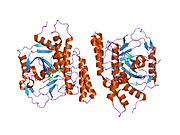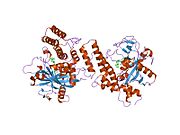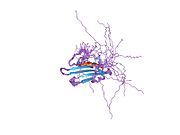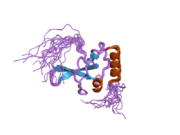PARP1
Ensembl | |||||||||
|---|---|---|---|---|---|---|---|---|---|
| UniProt | |||||||||
| RefSeq (mRNA) | |||||||||
| RefSeq (protein) |
| ||||||||
| Location (UCSC) | Chr 1: 226.36 – 226.41 Mb | Chr 1: 180.4 – 180.43 Mb | |||||||
| PubMed search | [3] | [4] | |||||||
| View/Edit Human | View/Edit Mouse |
Poly [ADP-ribose] polymerase 1 (PARP-1) also known as NAD+ ADP-ribosyltransferase 1 or poly[ADP-ribose] synthase 1 is an
Function
PARP1 works:
- By using NAD+ to synthesize poly ADP ribose (PAR) and transferring PAR moieties to proteins (ADP-ribosylation).[8]
- In conjunction with BRCA, which acts on double strands; members of the PARPfamily act on single strands; or, when BRCA fails, PARP takes over those jobs as well (in a DNA repair context).
PARP1 is involved in:
- Differentiation, proliferation, and tumor transformation
- Normal or abnormal recovery from DNA damage
- May be the site of mutation in Fanconi anemia[citation needed]
- Induction of inflammation.[9]
- The pathophysiology of type I diabetes.[10]
PARP1 is activated by:
- gastric cancer.[11]
Role in DNA damage repair
PARP1 acts as a first responder that detects DNA damage and then facilitates choice of repair pathway.[12] PARP1 contributes to repair efficiency by ADP-ribosylation of histones leading to decompaction of chromatin structure, and by interacting with and modifying multiple DNA repair factors.[6] PARP1 is implicated in the regulation of several DNA repair processes including the pathways of nucleotide excision repair, non-homologous end joining, microhomology-mediated end joining, homologous recombinational repair, and DNA mismatch repair.[12]
PARP1 has a role in repair of single-stranded DNA (ssDNA) breaks. Knocking down intracellular PARP1 levels with
Role in inflammation
PARP1 is required for NF-κB transcription of proinflammatory mediators such as tumor necrosis factor, interleukin 6, and inducible nitric oxide synthase.[9][18] PARP1 activity contributes to the proinflammatory macrophages that increase with age in many tissues.[19] ADP-riboyslation of the HMGB1 high-mobility group protein by PARP1 inhibits removal of apoptotic cells, thereby sustaining inflammation.[20]
In asthma PARP1 facilitates recruitment and function of immune cells, including CD4+ T-cells, eosinophils, and dendritic cells.[18]
Over-expression in cancer
PARP1 is one of six enzymes required for the highly error-prone DNA repair pathway microhomology-mediated end joining (MMEJ).[21] MMEJ is associated with frequent chromosome abnormalities such as deletions, translocations, inversions and other complex rearrangements. When PARP1 is up-regulated, MMEJ is increased, causing genome instability.[22] PARP1 is up-regulated and MMEJ is increased in tyrosine kinase-activated leukemias.[22]
PARP1 is also over-expressed when its promoter region ETS site is epigenetically hypomethylated, and this contributes to progression to endometrial cancer,[23] BRCA-mutated ovarian cancer,[24] and BRCA-mutated serous ovarian cancer.[25]
PARP1 is also over-expressed in a number of other cancers, including neuroblastoma,[26] HPV infected oropharyngeal carcinoma,[27] testicular and other germ cell tumors,[28] Ewing's sarcoma,[29] malignant lymphoma,[30] breast cancer,[31] and colon cancer.[32]
Cancers are very often deficient in expression of one or more DNA repair genes, but over-expression of a DNA repair gene is less usual in cancer. For instance, at least 36 DNA repair enzymes, when mutationally defective in germ line cells, cause increased risk of cancer (hereditary
Interaction with BRCA1 and BRCA2
Both
Application to cancer therapy
Aging
PARP activity (which is mainly due to PARP1) measured in the permeabilized mononuclear
PARP1 appears to be resveratrol's primary functional target through its interaction with the tyrosyl tRNA synthetase (TyrRS).[40] Tyrosyl tRNA synthetase translocates to the nucleus under stress conditions stimulating NAD+-dependent auto-poly-ADP-ribosylation of PARP1,[40] thereby altering the functions of PARP1 from a chromatin architectural protein to a DNA damage responder and transcription regulator.[41]
The messenger RNA level and protein level of PARP1 is controlled, in part, by the expression level of the ETS1 transcription factor which interacts with multiple ETS1 binding sites in the promoter region of PARP1.[42] The degree to which the ETS1 transcription factor can bind to its binding sites on the PARP1 promoter depends on the methylation status of the CpG islands in the ETS1 binding sites in the PARP1 promoter.[23] If these CpG islands in ETS1 binding sites of the PARP1 promoter are epigenetically hypomethylated, PARP1 is expressed at an elevated level.[23][24]
Cells from older humans (69 to 75 years of age) have a constitutive expression level of both PARP1 and PARP2 genes reduced by half, compared to their levels in young adult humans (19 to 26 years old). However, centenarians (humans aged 100 to 107 years of age) have constitutive expression of PARP1 at levels similar to those of young individuals.[43] This high level of PARP1 expression in centenarians was shown to allow more efficient repair of H2O2 sublethal oxidative DNA damage.[43] Higher DNA repair is thought to contribute to longevity (see DNA damage theory of aging). The high constitutive levels of PARP1 in centenarians were thought to be due to altered epigenetic control of PARP1 expression.[43]
Both sirtuin 1 and PARP1 have a roughly equal affinity for the NAD+ that both enzymes require for activity.[44] But DNA damage can increase levels of PARP1 more than 100-fold, leaving little NAD+ for SIRT1.[44]
Role in cell death
Following severe DNA damage, excessive activation of PARP1 can lead to cell death.[45] Initially, overactivation of the enzyme was linked to apoptotic cell death[46][47] but later, PARP1-mediated cell death turned out to show characteristics of necrotic cell death (i.e. early plasma membrane disruption, structural and functional mitochondrial alterations).[48][49] These findings provided explanation for previous and subsequent reports demonstrating tissue protective effects of PARP inhibitors and the PARP1 knockout phenotypes in various models of ischemia-reperfusion injury (e.g. in stroke, in the heart and in the gut) where oxidative stress-induced cell death is a central cellular event.[50] Later, apoptosis inducing factor (AIF; a misnomer) was identified as a key mediator of the PARP1-mediated regulated necrotic cell death pathway termed parthanatos.[51]
Plant PARP1
Plants have a PARP1 with substantial similarity to animal PARP1, and roles of poly(ADP-ribosyl)ation in plant responses to DNA damage, infection and other stresses have been studied.[52][53] Intriguingly, in Arabidopsis thaliana (and presumably other plants), PARP2 plays more significant roles than PARP1 in protective responses to DNA damage and bacterial pathogenesis.[54] The plant PARP2 carries PARP regulatory and catalytic domains with only intermediate similarity to PARP1, and carries N-terminal SAP DNA binding motifs rather than the Zn-finger DNA binding motifs of plant and animal PARP1 proteins.[54]
Interactions
PARP1 has been shown to
See also
- DNA damage theory of aging
- Maximum lifespan
- Olaparib – a PARP inhibitor
- PARP inhibitor class of investigational anti-cancer drugs
- Parthanatos
- Poly ADP ribose polymerase
- Senescence
References
- ^ a b c GRCh38: Ensembl release 89: ENSG00000143799 – Ensembl, May 2017
- ^ a b c GRCm38: Ensembl release 89: ENSMUSG00000026496 – Ensembl, May 2017
- ^ "Human PubMed Reference:". National Center for Biotechnology Information, U.S. National Library of Medicine.
- ^ "Mouse PubMed Reference:". National Center for Biotechnology Information, U.S. National Library of Medicine.
- S2CID 41201067.
- ^ PMID 33028824.
- S2CID 240110114.
- S2CID 211028760.
- ^ PMID 23050038.
- ^ "Entrez Gene: PARP1 poly (ADP-ribose) polymerase family, member 1".
- PMID 19897724.
- "Team finds link between stomach-cancer bug and cancer-promoting factor". Medical Xpress. January 6, 2010.
- ^ PMID 30177435.
- PMID 18603595.
- PMID 12930944.
- PMID 1945881.
- PMID 20660013.
- PMID 7698643.
- ^ PMID 28974953.
- PMID 32774895.
- PMID 31877876.
- PMID 25789972.
- ^ PMID 25828893.
- ^ PMID 23762867.
- ^ PMID 24448423.
- PMID 23442605.
- PMID 25563294.
- PMID 30087144.
- S2CID 535704.
- PMID 11956622.
- S2CID 26905918.
- PMID 21908496.
- PMID 25526641.
- PMID 29514064.
- S2CID 4391043.
- S2CID 4364706.
- PMID 1465394.
- S2CID 24616650.
- PMID 12707040.
- PMID 29511347.
- ^ PMID 25533949.
- PMID 25136112.
- PMID 10435618.
- ^ PMID 17518695.
- ^ S2CID 25896400.
- S2CID 43817844.
- PMID 8535170.
- PMID 9168807.
- PMID 9767416.
- S2CID 5734113.
- S2CID 27100634.
- S2CID 22991897.
- PMID 21482174.
- PMID 27907213.
- ^ PMID 25950582.
- ^ PMID 15044383.
- PMID 5555565.
- PMID 10744766.
- PMID 11590148.
- PMID 9565608.
- ^ PMID 9518481.
- PMID 9584196.
- PMID 14623329.
Further reading
- Rosado MM, Bennici E, Novelli F, Pioli C (August 2013). "Beyond DNA repair, the immunological role of PARP-1 and its siblings". PMID 23489378. Review of the subject.







